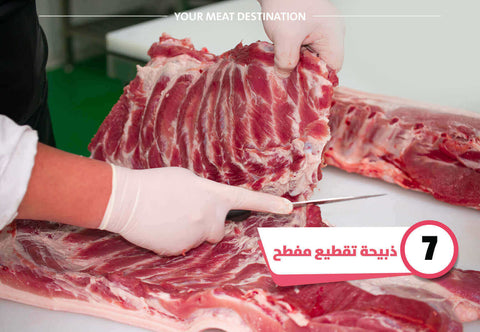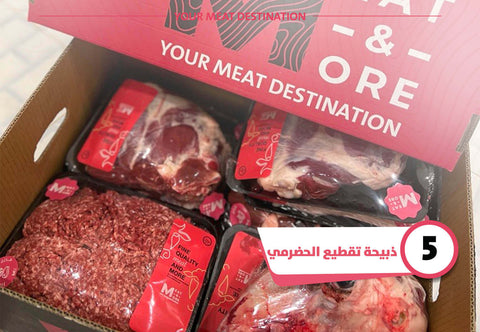What is the flat cut of the carcass?
The Muftah cut is characterized by dividing the carcass into two main parts:
- Forequarter: This portion includes the shoulder with ribs cut into large pieces and formed with the bone.
- The hind half with the loin: This part remains intact and uncut, and contains the loin and a number of ribs.
In addition to these two main sections, internal organs such as the liver, heart, kidneys, head, gizzard, and rumen are separated.
Features of the Mutafatah slaughterhouse:
- Preserving the natural shape of the carcass: Many people prefer it to preserve the traditional shape of the carcass and facilitate the cooking process.
- Cooking versatility: This cut allows for a variety of dishes to be prepared from each part. Large shoulder cuts can be grilled or oven-baked, while broths and soups can be prepared from the back half, head, and trotters.
- Ease of distribution: Large pieces can be distributed to more than one person or family.
When do you choose the flat cut for your slaughter ?
- Large families: Suitable for large families who wish to distribute the sacrifice among several individuals or for special occasions.
- Traditional cooking lovers: Preferred by those who want to maintain the traditional way of cooking meat.
- Those who want control over the cutting process: This cutter allows the buyer to cut the meat according to their desire and needs.
What will you get when you order a piece of Moftah? And the suggested preparation methods
|
Product |
Common uses |
|
Bone problem, big detail |
Grill, oven bake, prepare kebabs. |
|
Half back with night |
Preparing broth, soup, and Kabsa. |
|
Liver, heart and kidneys |
Grill, fry, add to soup. |
|
The head is skinned |
Prepare broth, soup. |
|
trotters |
Prepare broth, soup, eat it boiled. |
|
belly |
Preparing the mombar, mansaf, and stuffing it with rice or minced meat. |
Note: The cooking method of each portion can be modified according to preference and family traditions.
a summary:
The Muftah cut is an excellent choice for those who prefer to maintain the traditional appearance of the carcass and desire a variety of dishes that can be prepared from it. However, care must be taken to ensure the cleanliness of the meat and to store it properly to maintain its quality and safety.








Comments (0)
There are no comments for this article. Be the first one to leave a message!